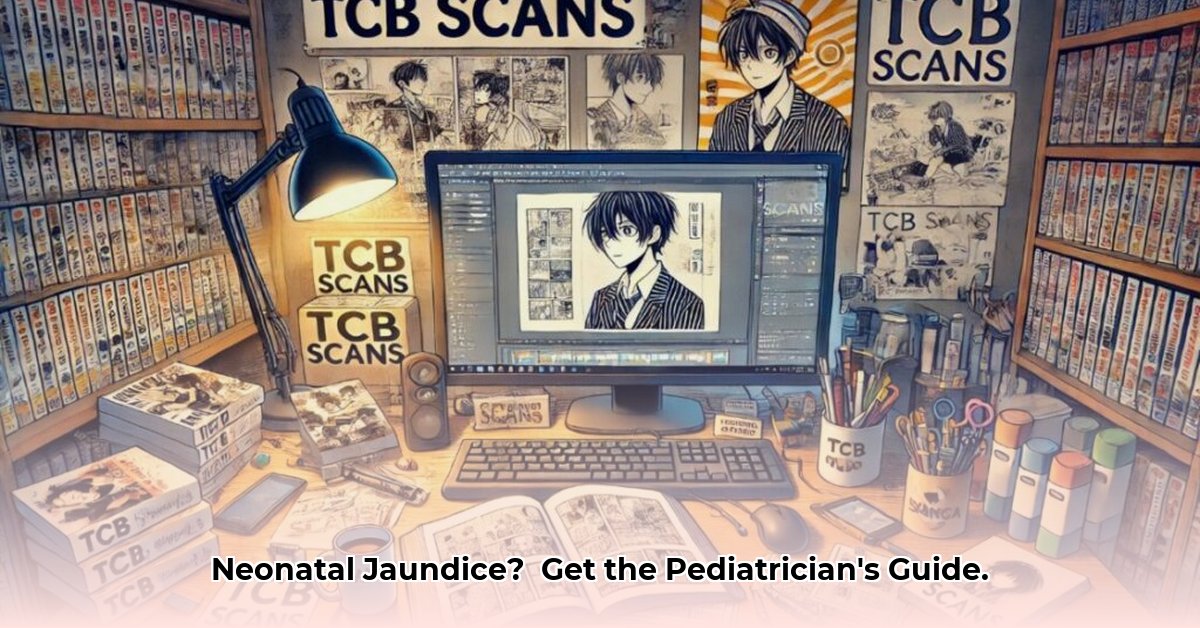Newborn jaundice, characterized by a yellowish tint to your baby’s skin and eyes, is a common occurrence. This article provides a comprehensive understanding of transcutaneous bilirubin (TcB) scans, frequently recommended by pediatricians, as a vital tool for the detection and management of neonatal jaundice. We will explore the accuracy of these scans, the various screening approaches, treatment options like phototherapy, and the importance of ongoing research in this field. For more detailed guidelines on TcB scans, see these guidelines.
Neonatal Jaundice: An Overview
Neonatal jaundice is a condition that affects many newborns, causing their skin and eyes to appear yellowish. While typically benign and resolving on its own, severe cases can lead to serious complications if left unmanaged. Early detection is paramount, and TcB scans play a key role in this process.
What Causes Jaundice in Newborns?
Jaundice arises due to the immaturity of the newborn’s liver, which is not yet fully capable of processing bilirubin, a byproduct of red blood cell breakdown. In most instances, this is a normal physiological process that resolves within a few weeks. However, elevated bilirubin levels can pose a risk to the brain, potentially leading to a condition known as kernicterus. Therefore, timely detection and intervention are essential to prevent this serious complication.
The Role of TcB Scans: A Non-Invasive Approach
TcB scans (transcutaneous bilirubin measurements) are a non-invasive method used by healthcare providers to assess bilirubin levels in newborns. This procedure involves using a specialized device to measure bilirubin levels through the baby’s skin. It is a painless and needle-free process that provides doctors with an estimate of bilirubin levels without the need for a blood test.
Accuracy and Limitations of TcB Scans
While TcB scans are a valuable screening tool, it’s important to understand their accuracy and limitations. TcB scans provide a reliable estimate of bilirubin levels, enabling doctors to obtain an initial reading. However, their accuracy may be compromised when bilirubin levels are exceptionally high. In such cases, a blood test (total serum bilirubin or TSB) might be necessary to obtain a more precise measurement. This comprehensive approach allows doctors to make informed treatment decisions tailored to each baby’s specific needs.
Screening Strategies: Universal vs. Targeted
The optimal approach to jaundice screening (universal vs. selective) is an ongoing discussion among healthcare professionals.
- Universal Screening: This strategy involves screening every newborn for jaundice. Proponents argue that it helps detect a greater number of cases, ensuring early intervention. However, it may also lead to unnecessary procedures and increased parental anxiety in some instances.
- Targeted Screening: This approach focuses on screening newborns with specific risk factors for developing significant jaundice. This approach can help conserve resources and reduce parental anxiety; however, there is a risk of missing cases of jaundice in newborns without identified risk factors.
The choice of screening strategy depends on the available resources, the prevalence of jaundice in the population, and the specific needs of the community.
Phototherapy: A Common Treatment for Jaundice
If a baby’s bilirubin levels are deemed too high, doctors may recommend phototherapy. This treatment involves placing the baby under special blue or white lights that help break down bilirubin in the skin. Phototherapy is generally safe and effective in most cases. However, ongoing research continues to explore the potential long-term effects of phototherapy to optimize its safety and efficacy.
Advancements in Jaundice Management
Research into neonatal jaundice management is an ongoing process. Scientists are focused on developing more accurate and reliable TcB devices, exploring novel screening methods, and gaining a deeper understanding of how bilirubin affects a baby’s development. These efforts are leading to improved guidelines, treatment strategies, and ultimately, better outcomes for newborns with jaundice.
Recommendations for Parents, Healthcare Professionals, and Policymakers
Effective management of neonatal jaundice requires collaborative efforts from all stakeholders.
For Doctors and Healthcare Professionals: Enhance risk assessment methods, improve the cost-effectiveness of screening programs, and regularly update phototherapy protocols based on the latest evidence. Conduct routine assessments of the quality and accuracy of TcB devices and related technologies.
For Parents: Educate yourselves about the risk factors for jaundice and openly discuss screening options, treatment plans, and any concerns you may have with your pediatrician.
For Policy Makers: Prioritize research into jaundice screening and invest in programs aimed at ensuring access to high-quality neonatal care for all newborns. Base healthcare decisions on evidence-based guidelines to improve outcomes for newborns.
Key Takeaways
Effective jaundice management relies on a delicate balance of early detection, accurate assessment, and appropriate intervention. TcB scans serve as a vital tool for early detection, and open communication between healthcare professionals and parents is crucial in making the best decisions for each baby’s individual needs.
Optimizing Neonatal Jaundice Screening: Cost-Effectiveness and Long-Term Health Outcomes
Neonatal jaundice, a prevalent condition affecting approximately 60% of newborns, necessitates effective and affordable screening strategies. Optimizing neonatal jaundice screening involves balancing the costs of various screening methods against the potential for preventing severe complications such as kernicterus. A comprehensive assessment is essential for achieving optimal outcomes.
Key Takeaways:
- Neonatal jaundice affects a significant proportion of newborns and requires efficient and cost-effective screening methods.
- Transcutaneous bilirubin (TcB) measurement offers a faster, less invasive alternative to traditional serum bilirubin (TSB) tests.
- Effective optimization of neonatal jaundice screening involves balancing screening costs with the potential to prevent severe complications such as kernicterus.
Significance of Neonatal Jaundice
Neonatal jaundice, characterized by a yellowish tinge in a baby’s skin, is a common condition caused by an accumulation of bilirubin in the bloodstream. While often harmless and self-resolving, severe jaundice, or hyperbilirubinemia, can lead to brain damage known as kernicterus, resulting in devastating, lifelong consequences. Early detection is crucial for preventing this serious complication.
TcB vs. TSB: A Comparative Analysis
Currently, the two primary methods for detecting elevated bilirubin levels are transcutaneous bilirubinometry (TcB) and total serum bilirubin (TSB) testing. TSB is considered the gold standard for accuracy but requires a blood draw, which can be distressing for newborns and their parents. TcB, on the other hand, is a non-invasive technique that uses a sensor to measure bilirubin levels through the skin. It is faster and less stressful for the baby, but its accuracy is slightly lower, especially at very high bilirubin levels.
Screening Strategies: Universal vs. Risk-Based
The debate over whether to screen every newborn (universal screening) or only those at higher risk (risk-based screening) remains a topic of discussion. Universal screening with TcB can detect more cases early, and while it may be more expensive upfront, this strategy can save money in the long run by preventing severe complications. Risk-based screening reduces costs by focusing on infants at risk but may miss some cases of jaundice in seemingly healthy newborns.
Benefits of Phototherapy Treatment
Phototherapy, which involves exposing the baby to special blue lights, is an effective treatment for lowering bilirubin levels and preventing the need for more aggressive interventions, such as exchange transfusions. It is a common and well-established intervention with minimal long-term effects.
Optimizing Screening: A Step-by-Step Approach
Optimizing neonatal jaundice screening for cost-effectiveness and long-term health outcomes necessitates a multi-faceted strategy:
- Selecting the Appropriate Test: TcB offers advantages in terms of speed and reduced invasiveness, but its accuracy must be carefully weighed against the higher precision of TSB.
- Implementing Standardized Procedures: Clearly defined protocols for screening and treatment can improve efficiency, reduce errors, and ensure consistency in care.
- Risk Stratification: Identifying and focusing on high-risk infants optimizes resource allocation and ensures timely intervention for those who need it most.
- Regular Calibration and Quality Control: Regular calibration and rigorous quality control measures are essential to ensure accurate measurements and appropriate management.
Future Directions in Jaundice Management
Research efforts continue to improve jaundice management and refine existing practices. Expect to see advancements in TcB devices that enhance their accuracy and affordability, as well as the development of more refined risk prediction models that allow for more targeted screening approaches.
“Early intervention is key to preventing severe complications from neonatal jaundice,” said [Dr. Emily Carter, MD], [Neonatologist] at [Stanford Children’s Health]. “TcB scans provide a valuable first step in assessing bilirubin levels, allowing for timely treatment when needed.”
Risk Factors for Severe Neonatal Jaundice Requiring Intervention
Understanding the risk factors for severe neonatal jaundice requiring intervention enables parents and healthcare providers to take appropriate management steps. These risk factors include prematurity, family history, certain genetic conditions, and breastfeeding challenges.
Key Takeaways:
- Early-term infants face a significantly higher risk of developing severe jaundice that requires intervention.
- Breastfeeding, while generally beneficial, can sometimes contribute to elevated bilirubin levels, necessitating careful monitoring.
- Specific genetic factors, such as G6PD deficiency, substantially increase the risk of severe jaundice.
Addressing Neonatal Jaundice
Jaundice, characterized by the yellowish tinge to a baby’s skin and eyes, is a common newborn condition. While generally benign, it is important to understand that severe jaundice, or hyperbilirubinemia, can be dangerous. TcB scans measure bilirubin levels in the skin, providing a quick and non-invasive method to assess the severity of jaundice and guide treatment decisions. Especially helpful
- Water Wheel Electric Generator Provides Free Home Electricity - December 15, 2025
- Choosing the Right Portable Hydro Turbine for Your Needs - December 14, 2025
- Best Portable Hydro Generators for Off-Grid and Outdoor Power - December 13, 2025















